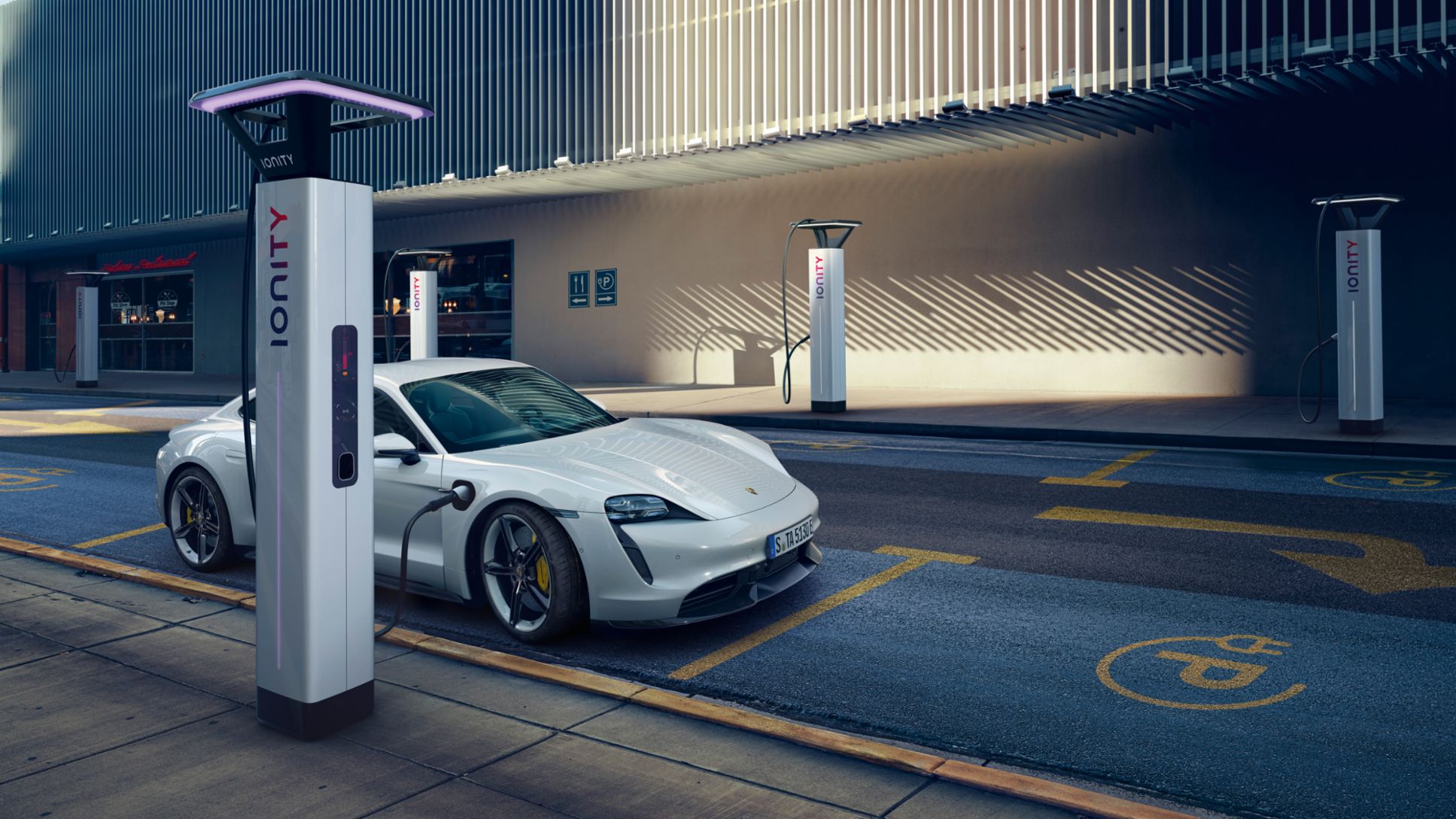Taycan drivers can comfortably charge their vehicles with up to 11 kW of alternating current (AC) at home. On the road, they benefit from the vehicle's 800-volt technology and the ingenious temperature control strategy for the battery. The Performance Battery Plus allows the vehicle to be charged with higher currents (direct current, DC), thus speeding up the process significantly: in just over five minutes, the battery can be recharged for a range of up to 100 kilometres (according to WLTP). The charging time for five to 80 percent SoC (state of charge) is 22.5 minutes in ideal conditions at 800-volt high-power charging stations, with a maximum charging capacity (peak) of 270 kW.
The Taycan has charge ports in the two front side sections of the body. The vehicle can be charged on both sides using alternating current (in most markets), on the right-hand side it can also be charged using direct current. The connections are protected from the weather by electric charge port doors. A small ice-breaker ensures that they still work in heavy frost. This breaks up ice crusts, clearing the way for the port door. In this case, the port doors are opened by means of hand gesture. Alternatively, the electric charge port doors can also be operated from the interior via the centre console control panel.
For charging at 400-volt charging points, an on-board DC charger, initially with 50 kW and optionally 150 kW, is installed. An on-board AC charger with 11 kW for charging using alternating current is also installed. This fully and gently charges the battery in circa nine hours.
Porsche also offers the following charging equipment:
-
With a capacity of up to 11 kW, Porsche Mobile Charger Connect is a quick and convenient way to charge the Taycan at home overnight.
-
With the portable, three-kilogram Porsche Mobile Charger Plus (available from mid-2020), it can be charged at home or on the road with a maximum of 11 kW.
-
Mode 3 cable: A 4.5-metre charging cable for charging at public alternating current charging stations.
-
Home Energy Manager (HEM): The intelligent control centre can be integrated into the domestic power grid by an electrician and ensures problem-free and convenient charging at home. The Home Energy Manager optimises the charging process in terms of performance, time and costs. It also offers protection against overloading the domestic network (blackout protection) by reducing the charging power of the vehicle as required in the event of an imminent overload, thus preventing the domestic fuse from being triggered (blackout).
The Porsche Charging Service enables worldwide access to charging points from various providers. Central billing takes place via Porsche. More than 100,000 charging points will be linked in Europe by the time the Taycan is launched. Porsche is also supporting the global establishment of a fast-charging infrastructure, in some cases together with partners.
-
In the pilot cities of Shanghai, Beijing, Tokyo, Osaka, Nagoya and London, Porsche Charging offers customers the opportunity to charge their vehicles at selected locations at four of their own high-power charging points (with up to 350 kW).
-
As part of the joint venture Ionity – which also involves Audi, BMW, Daimler and Ford – Porsche will build around 400 high-power charging parks, with a capacity of up to 350 kW per charging point, across Europe by the end of 2020.
-
In addition, more than 2,000 AC charging points in up to 20 markets are available from Porsche Destination Charging, at destinations such as hotels, for the launch of the Taycan.
-
The Porsche dealer network will also be equipped with 800-volt high-power charging stations.
-
In North America, the VW Group initiative, Electrify America, has offered charging with up to 350 kW at 300 highway stations since this year.
-
Its subsidiary, Electrify Canada, is also pursuing the development of a high-power charging infrastructure to ensure long-distance mobility on motorways. By 2020, about 32 charging stations will be in operation in Canada.
-
Charging as Mobility Service (CAMS) is a joint venture of the Volkswagen Group. The aim is to put into operation around 4,000 charging points in 20 major Chinese cities by 2020.
-
In selected markets, Porsche is working with local partners on the development of a charging infrastructure with selectively installed, fast-charging corridors. By 2020, more than 60 charging stations are scheduled to be in operation in Australia, Brazil, Malaysia, Mexico, South Korea, Singapore, Taiwan, Thailand and the United Arab Emirates.
Charging made easy
According to a Porsche forecast, approximately 80 percent of Taycan owners will charge their batteries at home overnight. Porsche offers a multi-step review of owners’ individual charging situations and extensive charging equipment for this purpose.
At the Porsche Charging Pre-Check, interested parties can find out at an early stage whether charging at their home is generally possible. In a short online survey, information on the living and parking space situation, existing power connections and Internet availability is collected. Based on the responses, the potential customer will receive an initial forecast. If an individual consultation is requested, prospective customers can forward their Pre-Check-ID to a Porsche Centre.
The Porsche Centres also offer the Home Check before the vehicle is purchased. An electrician will check the conditions on site and can also install the charging station at a later date. The Porsche Centre will receive a report from the home visit in order to be able to provide the customer with the best possible advice on the choice of charging equipment.
These charging stations facilitate charging at home:
-
The Porsche Mobile Charger Connect combines intelligent charging functions with network and Internet connectivity. It can be used to charge the vehicle with 11 kW. With the "price-optimised charging" function, daytime and night-time periods, during which electricity is cheaper, are also used specifically for charging. Operation is intuitive via the five-inch touch display. Data such as the battery's current charging status and the remaining charging time can either be displayed on the screen or on a smartphone or tablet linked to it. Thanks to its WiFi functionality, the Mobile Charger Connect can also be networked with the Home Energy Manager so that intelligent charging functions can be used at home.
-
With the Porsche Mobile Charger Plus (available from mid-2020), the Taycan can be charged at home or on the road with a maximum of 11 kW. With its compact dimensions and weighing less than three kilograms, it is easy to transport. A wall bracket is supplied and can be mounted in the garage. The Porsche Mobile Charger Plus is then simply and securely attached using a clip-in system. With the Porsche Charging Dock Pedestal bracket and the attractively designed Porsche Compact Pedestal, both chargers are protected against external influences such as rain or vandalism. The devices can be removed from the docks.
The Home Energy Manager ensures problem-free charging at home and optimises the charging process in terms of performance, time and costs. When properly installed in the domestic mains by a specialist, it continuously monitors the energy requirement and the available power output of the power supply.
In addition, the Home Energy Manager is able to carry out vehicle charging processes when other domestic electrical appliances are typically not in use. The Home Energy Manager can also manage the charging processes of multiple vehicles at the same time. This takes into account such factors as timelines, prioritisation and planned departure times. The Home Energy Manager also helps to reduce charging costs. If a customer has an electricity tariff with lower costs at certain times, the Home Energy Manager can schedule the charging process to this time slot.
Charging in Europe: Porsche Charging Service with more than 100,000 charging poi
On journeys, customers can access the Porsche charging network via the Porsche Charging Service, which enables them to locate charging points and begin charging. Billing can also take place via centrally stored payment data. There is no need to register with the various operators. This is done across countries, at a guaranteed unit price per market, irrespective of currency. The relevant app and the Porsche navigation system guide customers to the selected charging station. The platform currently has over 70,000 charging points in twelve countries. More than 100,000 charging points will be linked in Europe by the time of the Taycan’s market launch.
The app provides real-time information on the location and availability of the charging stations as well as the price of a charging process. Identification takes place at the charging point
-
by QR code via the app or
-
via a Porsche ID Card, which users receive free of charge after registering for the service, or
-
via the Plug&Charge function where users just connect the charging plug.
An innovative feature is, among other things, the option of a rating function. This tells the user when a vehicle was last charged at a charging station and how up-to-date and reliable the information on the respective charging point is. The daily utilisation of the charging station is also displayed so that charging processes can be better planned.
In Germany, use of the Porsche Charging Service is included for the first three years. The fees for the charging processes themselves depend on the operator and the amount of electricity used. The prices are displayed in detail and, if requested, also graded according to power output class / charging speed. The app can be used on all mobile devices with iOS or Android operating systems. The service can be used by all drivers of hybrid or electric vehicles. The service is not limited to Porsche sports cars.
Ionity high-power charging network: 400 stations on major European transport rou
With the creation of the Ionity joint venture, the BMW Group, Daimler AG, Ford Motor Company and Porsche are paving the way for the most extensive high-power charging network for electric cars in Europe.
Ionity will build and operate a total of 400 high-power charging parks by the end of 2020. There are already 120 stations (as of: July 2019). These will be located on motorways and main transport routes in large parts of Europe. They will be publicly accessible and located at an average of 120 kilometres apart. Ionity is collaborating with strong business partners such as Tank & Rast, Shell and Circle K, and benefits in particular from the attractive locations of these partners. Each Ionity high-power charging park will have multiple charging points. The network uses the European charging standard Combined Charging System (CCS). The charging capacity of 350 kW per charging point enables suitably designed vehicles such as the Taycan to charge much faster than with currently available systems.
Additional content
Sports cars, redesigned with sustainability in mind. The first all-electric sports car, the Taycan, marks the beginning of a new era for Porsche as the company systematically expands its product range in the field of e-mobility. An overview.


